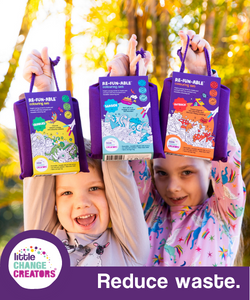Modern-day kids are overscheduled, overstimulated and just plain overwhelmed. There’s little time left for nurturing creativity, strengthening family relationships or to just relax and be present in a moment.
The rise of family overwhelm.
In recent times, family dynamics have been tested as parents grapple with the stress of being connected to their work 24/7 and kids adapt to increased screentime. In our quest to carve out some space, we sometimes turn to signing our kids up for an array of activities or handing over a tablet or phone. But neither is ideal – the first option often adds to our overwhelm as we rush from place to place trying to remember who needs what for which activity.
Devices offer a convenient solution, however, they riddle us with guilt because we know excessive screentime isn’t healthy, especially for kids. Research shows there’s an increasing reliance on screen-based devices for entertaining kids and, as a result, it’s impacting children’s ability to think creatively, to use their imagination, to develop their fine-motor skills and to problem-solve. It’s also causing disconnect within families.
Finding balance in the digital age
As parents, it’s concerning to see kids struggling with feelings of overwhelm, anxiety, or isolation. Unfortunately, this is becoming increasingly common among school children. With greater academic workloads, busy after-school schedules, distracted parents and social stressors, it’s no wonder so many kids are feeling this way.
The good news is that there are simple and effective strategies that can help children manage their feelings of overwhelm and apprehension. Mindfulness activities and creative play are just a couple of strategies that can have a positive impact on kid’s mental and emotional wellbeing.
Mindfulness Activities
Mindfulness activities draw on the principles of mindfulness to help kids develop an ability to focus their attention and stay present. According to Headspace, mindfulness is the practice of being fully engaged with whatever we’re doing at the moment — free from distraction or judgment, and aware of our thoughts and feelings without getting caught up in them.
Research has shown that mindfulness can help reduce stress and anxiety and improve emotional regulation, focus, and overall well-being, in kids and adults
Here are a few simple mindfulness activities that school children can do:
- Body scans: Let your child lay down or sit comfortably and focus on each part of their body, noticing any sensations and letting them be.
- Breathing exercises: Get your child to focus on their breath, counting each inhale and exhale, or picturing a peaceful scene.
- Gratitude practices: Give your child a moment each day to reflect on things they’re grateful for, such as family, friends, or special experiences.
“In today’s rush, we all think too much—seek too much—want too much—and forget about the joy of just being.” – Eckhart Tolle
So how can we further help kids to unwind and benefit from “the joy of just being” that Tolle refers to? Creativity! Whether it be drawing, colouring, music or dance, creative play is key to combatting anxiety and overwhelm in kids.
Creative Play
Creative play is a fun and engaging way for kids to express themselves, explore their emotions and just relax. This type of play can help kids develop important social and emotional skills as well as provide an outlet for stress and anxiety. Creative play is the foundation of educational philosophies such as the Reggio Emilia Approach, the Montessori Method and Waldorf Education.
Here are some creative play activities that children can try:
- Art projects: Use a variety of materials, such as paints, fabrics, clay or recycled packaging to construct pieces that express feelings or desires.
- Dramatic play: Act out different scenarios, such as solving problems or exploring emotions, using props and costumes.
- Music and dance: Listen to different styles of music and dance or sing along, allowing bodies and minds to move freely.
Another simple, yet highly-effective, way for kids to unwind, express themselves and explore their emotions is through colouring and drawing. Art researchers developed a study comparing drawing and colouring activities for relieving stress and anxiety, improving focus and enhancing overall wellbeing. While colouring seemed to be the winner in their study, it was clear that any kind of artistic activity is a mood-booster.
Here are some convenient colouring and drawing activities that kids can try:
- Reusable Colouring Mats: Kids love the captivating detail of these wipe-clean, silicone drawing mats. Parents are relieved too because mistakes are easily erased, averting countless tantrums and tears. These mats are compact, lightweight and dishwasher-safe, making them ideal for on-the-go entertainment and multi-purpose play.
- Freehand drawing: Kids can try different paper textures and media such as pencils, pastels or charcoal to draw whatever they like, without any specific instructions or restrictions.
Letting kids be kids
In summary, any non-digital activity that incorporates mindfulness and creativity provides kids with a sense of calm and control – and can be a good way to reconnect as a family. Colouring is one of the simplest and most-effective strategies to help school children manage feelings of overwhelm, anxiety, and stress. It’s easy for kids of any age and can also be an enjoyable way for parents to connect with their child. If you’re looking for a simple way for your child to unwind after school, explore their inner-artist and improve your family’s wellbeing, check out Little Change Creators’ Re-FUN-able Colouring Sets: www.littlechangecreators.com/collections/re-fun-able-colouring-sets








